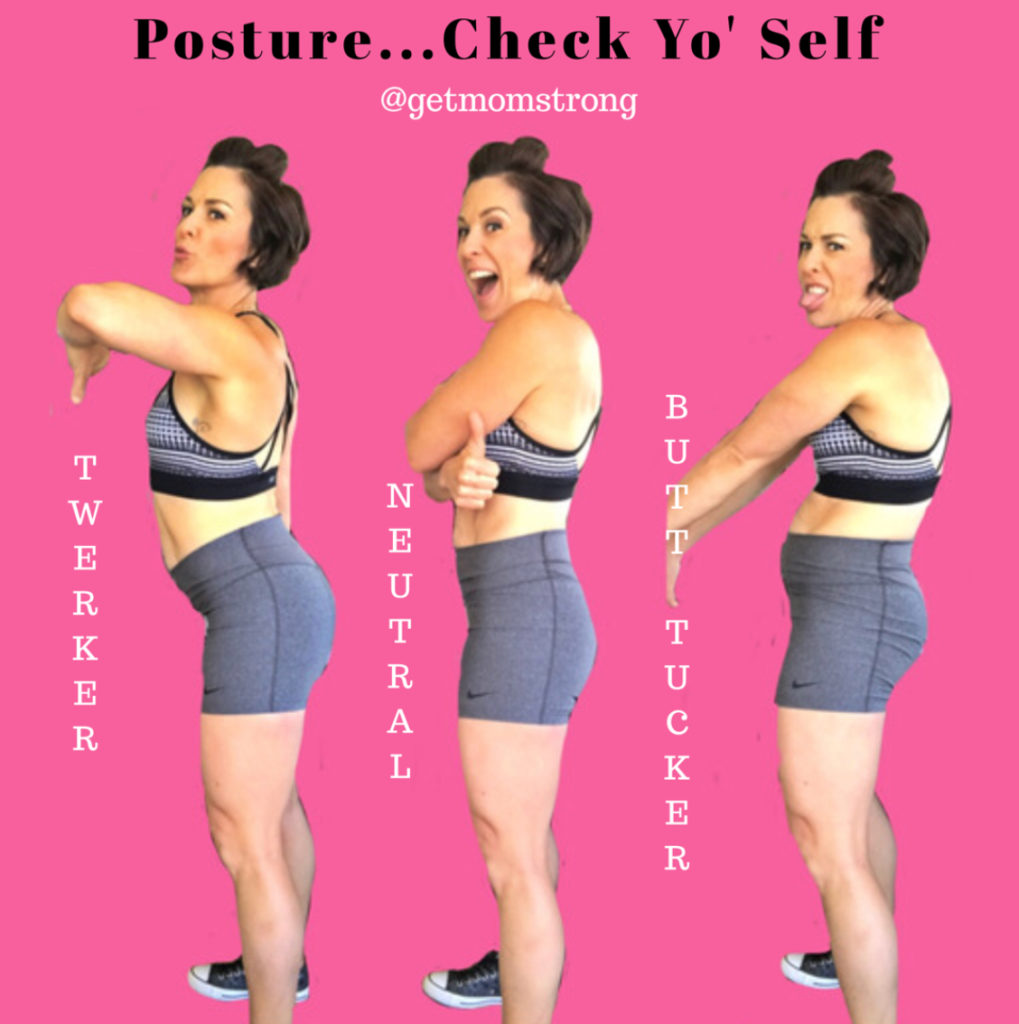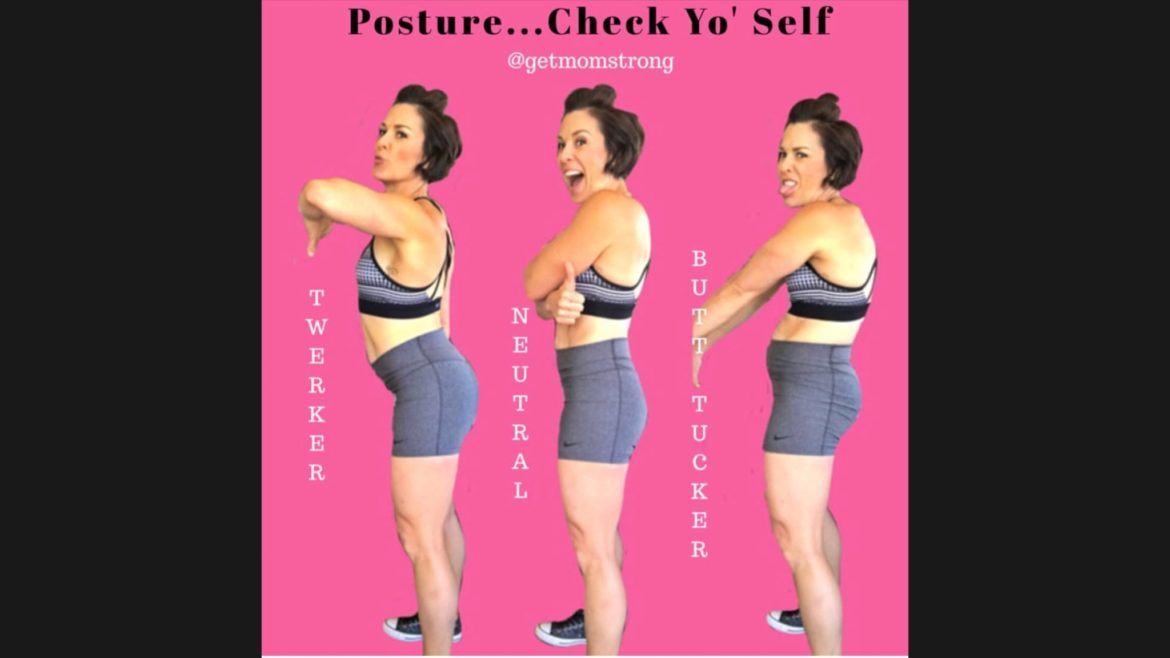Hey mama. How do you stand? Weird question, right? But seriously. Put down your phone and go look in a mirror. Better yet, snap a picture of yourself from the side. Take note. Does your butt stick out like the Twerker Ashley on the left who looks like she is going to the club? Or do you tuck those glutes like you tuck the ice cream in the back of the freezer. You know you do…don’t lie.

It is incredibly common for our posture to go to crap postpartum. Why? Well, we lose touch with our glutes, hip flexors and core thanks to that big old baby tummy and shifting center of gravity. After baby arrives, we are left with a Jello core, weak glutes and lousy hip flexors AND now we have to lug around a kiddo (or a few) with our body all out of whack. Thanks, kids. These postural habits are compensatory measures to overcome weakness, and we get stuck in these habits.
So let’s talk about it.
Understanding how the pelvis and rib cage ought to align. Knowing better is the first step to doing better!
My hope for you today is to discover why neutral alignment allows you to best find the support of the core and pelvic floor…not only in the gym, but as you move about your day.
Think back to those kegels you just did! When you leaned forward, you likely felt your kegel more in the front (clitoris area), and conversely, when leaning back and slouching, you may have felt it more in your anus. The neutral position should allow you to feel the entire support of the pelvic floor.

Square Those Hips. This is a cue to remind you that you can best lift or carry when your hips are squared and your core is engaged.
Carrying a kid? Square those hips. Carrying a car seat? Square those hips. Carrying groceries? Square em’!
The two most common postural compensations when lifting heavy things like your big old pile of kid…is the hip jut (hip out to the side as is pictured), or the extreme sway back when you arch your low back and grip your butt cheeks like you are suffocating your undies (this posture is common when babywearing).
Here are a few tips to help you carry heavy things (and humans).
- Core should be turned on. What I mean is to use those obliques and transverse abdominis (deep abdominals), and try not to let the weight of the kid pull you down. Think about keeping hips squared and shoulders squared. This means…
- Your arms need to do some of the work, too. When you get tired. Switch sides. Varying your movement and positions is important.
- Be sure you aren’t arching low back and gripping your butt tight under for support. And don’t jut that hip out either.
- Keep bundle of joy close to your body to place less strain on body. The closer an object to your center of gravity, the more supported you are. You can see the weight of Miles pulls me down even in the “good” posture picture. Carrying kids is work. Aim to carry with optimal posture and also know that when you are exhausted or carrying a screaming child through a parking lot you may not remember these tips. But with practice, better positioning truly becomes second nature.
Tips to correct posture.
In addition to being mindful of your posture, there are ways to strengthen the muscles not doing their job!
- Posterior Tilt
If you hang out with your butt tucked under and griped tight, shoulders rounded and your neck out like a turkey…you are a MOTHER TUCKER! it is time to work on some muscle patterns that are holding you in this position.
Okay…we already talked about why alignment matters (breathing, back pain, strength, pelvic floor), and how to be more mindful of your posture. Now let’s focus on STRENGTHENING your muscles which are acting like lazy losers constantly mooching off other supports. If you hang out in posterior pelvic tilt, you likely also have rounded shoulders. This is a common posture in desk jockeys and moms (especially breastfeeding moms).
WEAKNESS patterns of this posture typically include weak back muscles, quads, and inner most abs, and TIGHT hamstrings and rectus abdominals (outer six pack abs) and lengthened hip flexors.
So…You need to focus on strengthening your upper back, low back (spine stabilizers), and quads. And as moms, we almost always need to strengthen our glutes and inner most abs.
This is a sampling of a few exercises that might help strengthen these typical imbalances. A good physical therapist or trainer can help you target your weakness, stretch your tightness and retrain your brain. You need the combo for true effectiveness.
- Anterior Tilt
Okay…we have gone over SO much. Brain overload (which is maybe why I spelled taut wrong in the video caption). But this one here is near and dear to me, because I am a recovering twerker.
Here is the deal with anterior pelvic tilt (aka duck butt, or twerker butt). It is super common in moms. Our #pregnant bellies shift the center of gravity. The result is an arched back. That’s how we compensate for that gravitational forward pull. We aren’t going to allow ourselves to fall flat on our faces, so we ask our low back to pull us back upright. That’s a shit-ton of work for your low back. And we often stay here #postpartum.
Twerker butt peeps typically have weak glutes, and overstretched and weak abs. And our low backs, hamstrings and hip flexors are tight AF!

The remedy? We need to focus on keeping our ribs down. That takes a retrain of the brain.
Try these movements to strengthen that weak core and glutes. Pulling the band overhead gives us feedback and forces our ribs to stay down. It is the next best thing to me watching you and whipping you when I see you arch your back. I’m kidding. But seriously…
